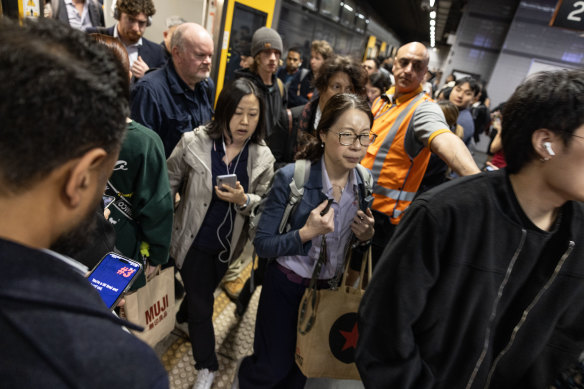This was published 5 months ago
Revealed: How Sydney metro is steering commuters away from old stations
The opening of Sydney’s $21.6 billion metro rail line under the central city has eased pressure on key heavy rail stations, as new figures show Town Hall and North Sydney have recorded drops in commuters passing through ticket gates.
The figures reveal commuters entering or exiting North Sydney slumped by 37 per cent to about 34,100 people on Tuesday, from the same day last week.
A day after the M1 line extension opened, the nearby Victoria Cross metro station was not far from reaching North Sydney station’s volumes as 29,630 people went in and out of the new hub’s gates.
Sydney’s busiest interchange station, Town Hall, recorded a 12 per cent fall to 148,333 people walking in or out of its entrances on Tuesday. The new Gadigal station had 28,027 people pass through its gates on its second day of operation.
The new underground metro stop is less than 150 metres from Town Hall station and a light rail stop, allowing commuters to switch between transport links. Gadigal station has a northern entrance on Pitt and Park streets, and a southern entrance on Bathurst Street.
Gadigal has long been seen as crucial to relieving pressure on Town Hall, which is a pinch point on Sydney’s double-deck rail network.
Museum station, which is also a short walk from Gadigal, posted a 7 per cent fall to 21,427 people on Tuesday from the prior period.
About 210,000 passengers travelled on the entire M1 line on Tuesday between Tallawong and Sydenham, up from 190,000 the day before when the main section of the extension under the central city opened in the early hours.
The figures show 65,000 passengers travelled on the M1 line in the five hours to 10am on Wednesday, up from 55,000 passengers in the same period a day earlier. Tuesdays, Wednesdays and Thursdays are the busiest on the transport network as more people travel to their workplaces, instead of working from home.
The final patronage figures for all stations are likely to be higher due to credit card and mobile phone payments taking longer to be recorded. It is also considered too early to draw firm trends from the patronage data about the impact of the new M1 line on commuter behaviour.
Nevertheless, Sydney transport expert Mathew Hounsell said Victoria Cross’ passenger volumes were “quite extraordinary” and were likely to be influenced by faster metro services and the station being closer to larger offices and schools.
“Clearly people are choosing to swap to the metro earlier. Rather than people changing to the north shore line, they have opted to go straight to the metro for all those people who have to change at Central to go from the south of the harbour to work in North Sydney,” he said.
“For them, it appears they have voted with their feet overwhelmingly and chosen the metro. Never underestimate how much people want to save walking.”

Peak hour at Town Hall station on Tuesday.Credit: Jessica Hromas
Hounsell said the figures indicated that Gadigal was reducing pressure on Town Hall, though he expected the volumes to be higher for that new metro station in the CBD than Victoria Cross.
He expects Gadigal to become more popular over time, especially on weekends due to its location in the heart of the shopping district in the CBD. Unlike at the new and old Martin Place stations, Gadigal is not linked to Town Hall by an underground walkway because transport planners wanted to avoid creating a mega-station there.
Transport for NSW secretary Josh Murray said it was early days for the extended metro line, but the agency was already seeing passengers make the most of new ways to crisscross the city.
“We will see new routes and interchanging behaviours emerge as passengers try the new metro city line, then settle on what new multi-modal journey works best for them,” he said.
“We’ve seen early passenger feedback from those who are experimenting with the new system; those who have made a deliberate switch for speed and efficiency, and those who are intending to stay with their current mode for other reasons.”
Start the day with a summary of the day’s most important and interesting stories, analysis and insights. Sign up for our Morning Edition newsletter.